Alison Stuart's Blog, page 8
June 14, 2016
Beyond Barbara... Historical Romance in the 21st century #WillyLitFest
 Go on – admit it! You are a little bit curious about the wonderful world of historical romance.
Go on – admit it! You are a little bit curious about the wonderful world of historical romance.You must have asked yourself at some point… Does a bodice really rip? Did Barbara Cartland really dictate all her historical romances to a secretary while sipping gin and cuddling Pekinese? Do modern day historical romance writers waft around in pink boas or eke out their sad, lonely little lives bent over the kitchen table while wearing fluffy slippers and a chenille dressing gown?
Three modern day historical romance writers are coming to the Willy Lit Fest to answer all your questions.
Among other things, we will discuss why we write historical romance. Famous and infamous figures who lived during the periods we write include Napoleon, Mad King George and Jane Austen. The world was in constant turmoil. England fought a bloody civil war, beheaded a king and lost the War of Independence for the United States of America.
Firstly, what is ‘romance’… and before you curl your lip, bear in mind that there is ‘romance’ in just about every book you have ever read!
According to the Romance Writers of America…
Two basic elements comprise every romance novel: a central love story and an emotionally satisfying and optimistic ending. A Central Love Story: The main plot centres around individuals falling in love and struggling to make the relationship work. A writer can include as many subplots as he/she wants as long as the love story is the main focus of the novel. An Emotionally Satisfying and Optimistic Ending: In a romance, the lovers who risk and struggle for each other and their relationship are rewarded with emotional justice and unconditional love. Romance novels may have any tone or style, be set in any place or time, and have varying levels of sensuality—ranging from sweet to extremely hot. These settings and distinctions of plot create specific subgenres within romance fiction. Click here to better understand the subgenres within romance.
For those who like statistics… bear these figures in mind.
In 2014, PRINT book sales in the US ‘Romance’ accounted for 31 million sales (just behind ‘General’ fiction at 34 million sales). The next highest seller in fiction was Suspense/Thrillers at 20million (figures Bookscan via Publishers Weekly)
Top romance subgenres by format read primarily:Print: romantic suspense (53%); contemporary romance (41%); historical romance (34%); erotic romance (33%); New Adult (26%); paranormal romance (19%); Young Adult romance (18%); and Christian romance (17%).E-book: romantic suspense (48%); contemporary romance (44%); erotic romance (42%); historical romance (33%); paranormal romance (30%); New Adult (26%); Young Adult romance (18%); and Christian romance (14%).So now you know, romance is a huge seller and not a genre to be lightly dismissed and neither are its writers!
Come and meet us and guess what… I don’t think we own a chenille dressing gown between us!
Alison Stuart is a local Williamstown resident, a ‘recovering’ lawyer and a former army officer.
Sasha Cottman is a Yarraville resident, finance executive and Regency period blogger.
Beverley Eikli is a full-time writer, former journalist, airborne geophysical survey operator and safari lodge manager.
We are thrilled to be invited to talk about, dare I say it, genre fiction among this august gathering of literary notables and apart from chocolate and prizes, we can promise you something a little bit different…
So! Is your curiosity piqued?
We will be featuring in Historical Romance in the 21 Century: Beyond Barbara Cartland in the Library Auditorium on Saturday 18 June at 3.30pm .
Tickets available now and our books will be available for sale and signing after the session.
Published on June 14, 2016 00:55
June 3, 2016
Flying into the Mist with Jo Beverley
The historical romance writing world is a sadder place this week with the death of historical romance writer, Jo Beverley.
I had the pleasure of meeting Jo at an RWAus conference and, on a visit to Canada, sharing lunch and a tour of the Victoria museum with her (she was a docent).
It is often the chance encounters that shape the direction of your life and if I had never stepped into her workshop at RWAm in 2001, I may have abandoned any pretension to being a writer. Jo gave me permission to be an organic writer (she called Flying Into the Mist) and I will love her forever.
This post is a repost about that workshop and the impact it had on me ... Thank you from the bottom of my heart, Jo!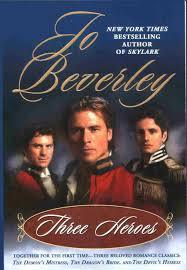 My favourite Jo Beverley... I think I bought it for the cover! Maybe it was the atmosphere of the "deep south" which was beginning to affect me, but when the very English Jo Beverley got up to speak at the RWA New Orleans conference in July 2001 it was all I could do not to leap to my feet my hands upraised and cry out "I hear you, sister!".
My favourite Jo Beverley... I think I bought it for the cover! Maybe it was the atmosphere of the "deep south" which was beginning to affect me, but when the very English Jo Beverley got up to speak at the RWA New Orleans conference in July 2001 it was all I could do not to leap to my feet my hands upraised and cry out "I hear you, sister!".
Conferences are full of workshops on plotting - using story boards, plot arcs, brainstorming – all sorts of wonderful suggestions to aid in pre-plotting a novel. The topic Ms Beverley (multi-published, RWA Honors List, historical writer) was talking on was the art of not plotting your book, or as she calls it, "Flying into the Mist".
It may surprise Jo Beverley fans to know that she does not pre-plot any of her books. For her, writing a novel is an ongoing mystery that unfolds before her when she sits down at her computer and the reason she chose to speak on this topic was to give permission to "flimmers" (and yes I am one of them!) to work this way.
I have been to the conferences, read the books, devoured the articles and in the earnest belief that I must be doing something wrong, I made several concerted attempts at pre-plotting a story. Instead of sailing into stress free writing I found I had got so bored with the story before I even started that I never got around to writing it. All the pleasure of writing had been taken away from me. So you can understand my enthusiasm when this evangelist of the non-plotters told me it was quite acceptable not to pre-plot and that I was not alone!
So what does "Flying into the Mist" mean? In Ms. Beverley's words, it means "that the writer does not pre-plot. No scene outlines, no plan for key scenes and dark moment. Not even a plan for theme or metaphor. These things reveal themselves as the writer writes."
That does not mean that a "flimmer" flies into the mist on autopilot. A good "flimmer" will have something in mind when they start – it may be a character, a setting, a scene or an incident. If you are writing romance you generally know the ending – the hero and heroine will end up together in a happily ever after embrace. How they get there is, for a "flimmer", the excitement!
Of course there are inherent risks in this method of writing and the obvious one is that you can waste an awful lot of time, flying in the wrong direction and then having to back track to put the story back on the right course. However I consider no writing wasted and in that diversion you may discover things about your characters that you can use at another point in time.
One thing I love about "flimming" is that the characters take on life and start to tell me things about themselves. It is almost as if a character will stop in the middle of the action and look at me, arms crossed, with a quizzical expression and the following conversation ensues:
Character: "I wouldn't do that."
Author: "Why not"
Character: "Because you have missed my motivation for acting the way I am. You know I am really looking for my brother."
Author (with surprise): "You have a brother?"
Character (with studied patience). "Yes, I have a brother. He is being held prisoner on an island…"
And so the conversation continues and a whole new character and plot line enters the story.
Jo Beverley overcomes problems with her characters by holding "character interviews", much along the line I have just outlined or she will use "mind mapping". Here a large sheet of paper or a whiteboard is essential. She will put the hero and heroine in circles in the middle of the sheet with some minor characters in smaller circles around them and then using lines map out the relationships between the characters and their problems and motivations.
How does she know that a particular plot line is (or is not) going to work? Jo will give herself three or four chapters into a story before she makes a decision on whether to continue or abort. She may find that the characters need rearranging or that the story is only just starting by Chapter Three .
Once the first draft is done, then Jo will go back with "all the tricks of the plotters trade" which she will use to strengthen the story: Key points, hero's journey, scene and sequel, metaphor and theme will all be used to turn that first draft into yet another best seller.
So why doesn't an experienced writer like Jo Beverley pre-plot her books? Because she feels pre-plotting drags her out of the present. She can have her characters conduct their interactions in a natural way without feeling she has to move them onto the next scene. "If I know what's supposed to happen next or later that distracts me from what's happening in the moment. I might even push the characters to certain words or actions instead of letting them do and say what they truly would."
Flying into the mist is a method of plotting (or non-plotting) that does not suit everyone. Do what feels natural to you, there is no right or wrong way to write your novel and if what you are doing works for you then go with it. Every writer is different.
For those closet-"flimmers", quietly reading your Hearts Talk in the comfort of your living room, I hope, like me, you are leaping from your chair, with your hands in the air shouting "I hear you sister!". Thank you Jo Beverley for giving us permission to "fly into the mist"!
(Quotes taken from "Flying into the Mist" by Jo Beverley - 2001 RWA Annual Conference and reprinted with her permission) Vale Jo Beverley...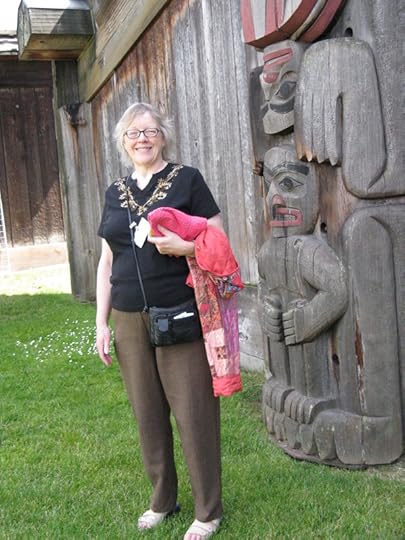 Jo at the museum in Victoria - July 2008
Jo at the museum in Victoria - July 2008
I had the pleasure of meeting Jo at an RWAus conference and, on a visit to Canada, sharing lunch and a tour of the Victoria museum with her (she was a docent).
It is often the chance encounters that shape the direction of your life and if I had never stepped into her workshop at RWAm in 2001, I may have abandoned any pretension to being a writer. Jo gave me permission to be an organic writer (she called Flying Into the Mist) and I will love her forever.
This post is a repost about that workshop and the impact it had on me ... Thank you from the bottom of my heart, Jo!
 My favourite Jo Beverley... I think I bought it for the cover! Maybe it was the atmosphere of the "deep south" which was beginning to affect me, but when the very English Jo Beverley got up to speak at the RWA New Orleans conference in July 2001 it was all I could do not to leap to my feet my hands upraised and cry out "I hear you, sister!".
My favourite Jo Beverley... I think I bought it for the cover! Maybe it was the atmosphere of the "deep south" which was beginning to affect me, but when the very English Jo Beverley got up to speak at the RWA New Orleans conference in July 2001 it was all I could do not to leap to my feet my hands upraised and cry out "I hear you, sister!".Conferences are full of workshops on plotting - using story boards, plot arcs, brainstorming – all sorts of wonderful suggestions to aid in pre-plotting a novel. The topic Ms Beverley (multi-published, RWA Honors List, historical writer) was talking on was the art of not plotting your book, or as she calls it, "Flying into the Mist".
It may surprise Jo Beverley fans to know that she does not pre-plot any of her books. For her, writing a novel is an ongoing mystery that unfolds before her when she sits down at her computer and the reason she chose to speak on this topic was to give permission to "flimmers" (and yes I am one of them!) to work this way.
I have been to the conferences, read the books, devoured the articles and in the earnest belief that I must be doing something wrong, I made several concerted attempts at pre-plotting a story. Instead of sailing into stress free writing I found I had got so bored with the story before I even started that I never got around to writing it. All the pleasure of writing had been taken away from me. So you can understand my enthusiasm when this evangelist of the non-plotters told me it was quite acceptable not to pre-plot and that I was not alone!
So what does "Flying into the Mist" mean? In Ms. Beverley's words, it means "that the writer does not pre-plot. No scene outlines, no plan for key scenes and dark moment. Not even a plan for theme or metaphor. These things reveal themselves as the writer writes."
That does not mean that a "flimmer" flies into the mist on autopilot. A good "flimmer" will have something in mind when they start – it may be a character, a setting, a scene or an incident. If you are writing romance you generally know the ending – the hero and heroine will end up together in a happily ever after embrace. How they get there is, for a "flimmer", the excitement!
Of course there are inherent risks in this method of writing and the obvious one is that you can waste an awful lot of time, flying in the wrong direction and then having to back track to put the story back on the right course. However I consider no writing wasted and in that diversion you may discover things about your characters that you can use at another point in time.
One thing I love about "flimming" is that the characters take on life and start to tell me things about themselves. It is almost as if a character will stop in the middle of the action and look at me, arms crossed, with a quizzical expression and the following conversation ensues:
Character: "I wouldn't do that."
Author: "Why not"
Character: "Because you have missed my motivation for acting the way I am. You know I am really looking for my brother."
Author (with surprise): "You have a brother?"
Character (with studied patience). "Yes, I have a brother. He is being held prisoner on an island…"
And so the conversation continues and a whole new character and plot line enters the story.
Jo Beverley overcomes problems with her characters by holding "character interviews", much along the line I have just outlined or she will use "mind mapping". Here a large sheet of paper or a whiteboard is essential. She will put the hero and heroine in circles in the middle of the sheet with some minor characters in smaller circles around them and then using lines map out the relationships between the characters and their problems and motivations.
How does she know that a particular plot line is (or is not) going to work? Jo will give herself three or four chapters into a story before she makes a decision on whether to continue or abort. She may find that the characters need rearranging or that the story is only just starting by Chapter Three .
Once the first draft is done, then Jo will go back with "all the tricks of the plotters trade" which she will use to strengthen the story: Key points, hero's journey, scene and sequel, metaphor and theme will all be used to turn that first draft into yet another best seller.
So why doesn't an experienced writer like Jo Beverley pre-plot her books? Because she feels pre-plotting drags her out of the present. She can have her characters conduct their interactions in a natural way without feeling she has to move them onto the next scene. "If I know what's supposed to happen next or later that distracts me from what's happening in the moment. I might even push the characters to certain words or actions instead of letting them do and say what they truly would."
Flying into the mist is a method of plotting (or non-plotting) that does not suit everyone. Do what feels natural to you, there is no right or wrong way to write your novel and if what you are doing works for you then go with it. Every writer is different.
For those closet-"flimmers", quietly reading your Hearts Talk in the comfort of your living room, I hope, like me, you are leaping from your chair, with your hands in the air shouting "I hear you sister!". Thank you Jo Beverley for giving us permission to "fly into the mist"!
(Quotes taken from "Flying into the Mist" by Jo Beverley - 2001 RWA Annual Conference and reprinted with her permission) Vale Jo Beverley...
 Jo at the museum in Victoria - July 2008
Jo at the museum in Victoria - July 2008
Published on June 03, 2016 00:47
May 9, 2016
In celebration of the crazy world of EUROVISION... let's take a visit to Brugel and the mad world of Ondine!

It is my great pleasure to welcome YA ("young adult") author, Ebony McKenna today. It is a little known fact about Ebony, but she is the world's expert on the politics and history of the (fictional) kingdom of Brugel, a small country somewhere in Eastern Europe and famous mainly for its utter failure to achieve anything at the Eurovision song contest.
It is my great pleasure to welcome YA ("young adult") author, Ebony McKenna today. It is a little known fact about Ebony, but she is the world's expert on the politics and history of the (fictional) kingdom of Brugel, a small country somewhere in Eastern Europe and famous mainly for its utter failure to achieve anything at the Eurovision song contest.
I hope you all enjoy this chance to learn something about a hitherto little known corner of our world and perhaps add Brugel to your tourist destinations on your next trip to Europe?
And if you're wondering why Brugel is not in this year's Eurovision it's because the Brugel organising committee (the BBC - Brugel Broadcasting Committee) missed the email from the EBU. They forgot to check the spam filter.
Then they got in after Romania was disqualified but were disqualified for breaching EBU (European Broadcasting Union) regulations about livestock on stage following their entrant's proposal to milk Snow Goats live on stage and protests from animal rights activists.
(For more about BRUGELESE SNOW GOATS, click HERE)

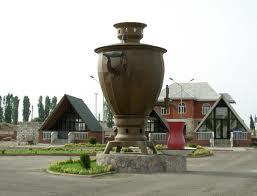 A public samovar in downtown Venzelemma
Ebony I have recently returned from Russia where tea is the most popular beverage (not Vodka!) and is made using huge samovars. Does Brugel have its own tea ceremonies?
A public samovar in downtown Venzelemma
Ebony I have recently returned from Russia where tea is the most popular beverage (not Vodka!) and is made using huge samovars. Does Brugel have its own tea ceremonies?
Oh yes, the Brugelish love of tea goes foot-in-boot with Russia. Samovari (the Brugelish name for one who prepares tea from a samovar) are more popular than Baristas in downtown Venzelemma.
Tea has always been a favourite of Brugelers. Coffee did gain a small foothold, but during the communist years, when Brugel was part of the USSR, Coffee became incredibly hard to obtain. The neighbouring state of Craviç tried growing Chicory as a substitute. Vile stuff. People switched back to tea, as this was easy to obtain through trade routes with China.
In Brugel, tea is often taken with a slice of lemon, rather than milk. This leads to the local idiom - I’ll take it with a slice of lemon - meaning you don’t entirely believe them. The more popular western phrase, “I’ll take that with a grain of salt” makes no sense in Brugel, as tea with salt tastes horrid.
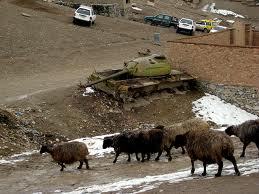 Monument to the Russian occupation in central Venzelemma
As you know, my interest is historical fiction and just recently we were discussing the hitherto little known history of Brugel (so insignificant that every major tyrant in history has bypassed it).
Monument to the Russian occupation in central Venzelemma
As you know, my interest is historical fiction and just recently we were discussing the hitherto little known history of Brugel (so insignificant that every major tyrant in history has bypassed it). Would you care to give us a potted version of Brugelese History?
Brugel has a marvellous and yet conveniently ignored history.
Settlement in the region can be traced back to nomadic goat herding tribes wandering through (on their way to better pastures) from at least 10,000 BC.
Historians are still vibrantly discussing the ensuing 12,000 years of Brugelese (or Brugelish, depending on which team you’re on) history. At a town called D’senterie, in the northernmost part of Brugel there is a historical marker dedicated to the place where Napoleon’s army rested for an afternoon. They picked Brugel Oak nuts and crushed them for a delicious sauce to dress the boiled chicken. This is also the first recorded outbreak of gastric upset in the Napoleonic Campaign.
Brugel has survived through many hardships, having been annexed into the Constantine, Austro-Hungarian, Prussian and Holy Roman empires at various – and mercifully short – times in history. In the 1950s Soviet tanks often rumbled through the main streets of Venzelemma – on their way to somewhere else.
It’s a little known fact that Brugel is the home of the sundial. This was more by tradition than design, from the days when sensible folk would abstain from drinking before the shadow of the castle tower cleared the main road. Would you recommend visiting Brugel as a tourist? What would be highlights?
The latest campaign from the Brugel Tourism Board is, “The Weekend Starts on Wednesday.” BrugelAir has free one-way flights to Venzelemma from Prague, every Wednesday for the foreseeable future. Unfortunately, there are no return flights, but I hear the train journeys to Slaegal the following Tuesday evoke equal measures of nostalgia and sciatica.
There are so many wonderful highlights; it’s hard to know where to start. Probably the most beautiful part of Brugel is the beach. (Singular, Brugel only has one). This one-hundred-metre-long strip of waterfront at the Black Sea is a charming way to fill a half hour on a summer morning.
It’s best to head into Venzelemma for the rest of the day, as the fishing boats return with their catches around ten and are not refrigerated.
Hiking is a popular pastime, as Brugel has the most manageable hills in all of Europe. Mt Verka Seduchka is the highest point, at a mighty 200 metres above sea level. It is also home to the transmission tower for BTV. The tower’s crumbling foundations and acute lean make for some dramatic photographs.
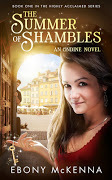 I adore the Ondine series, even though they are strictly speaking, “Young Adult” (one can be young at heart!). SUMMER OF SHAMBLES, THE AUTUMN PALACE, THE WINTER OF MAGIC and THE SPRING REVOLUTION are available from Amazon and all good estores
I adore the Ondine series, even though they are strictly speaking, “Young Adult” (one can be young at heart!). SUMMER OF SHAMBLES, THE AUTUMN PALACE, THE WINTER OF MAGIC and THE SPRING REVOLUTION are available from Amazon and all good estores
I can attest that these are not just books for youngsters. They had me laughing out loud ... most undignified I know (and somewhat alarming for my husband) ... but there you go. Sometimes you just find something that tickles the funnybone!
ABOUT EBONY...
Ebony McKenna lives in Melbourne, Australia with her family, living the slob-urban dream. She loves trivia nights, train sets and the Eurovision Song Contest. Despite having such a deep and abiding love for ferrets, her only pets are two RSPCA-rescue rabbits and the ring-tail possums that keep getting into the roof. Connect with Ebony at her WEBSITE and Facebook
To celebrate Eurovison
THE SUMMER OF SHAMBLES
Book 1 in the Ondine Stories is currently
**FREE** This is a revisied reblog of my post popular blog post EVER... You can see the original HERE
Published on May 09, 2016 01:02
April 29, 2016
Last chance to pick up SECRETS IN TIME for **FREE**
SECRETS IN TIME is returning to its RRP... so jump now if you want to grab it for free.
The download links are here: my link text

The download links are here: my link text

Published on April 29, 2016 16:21
•
Tags:
free-book, historical-time-travel, secrets-in-time
April 25, 2016
The war that killed a town... Anzac Day 2016
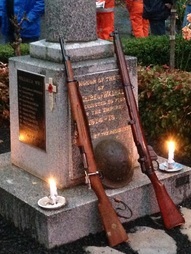 The old gold mining town of Walhalla lies almost forgotten, buried deep in the steep valleys of Victoria’s high country. In 1914 it was a bustling, thriving community. The gold mines were producing well and providing employment for hundreds of men. Busy hotels and shops lined the main (and only!) street. A railway had been pushed through the inhospitable country to link the community with the outside world.
The old gold mining town of Walhalla lies almost forgotten, buried deep in the steep valleys of Victoria’s high country. In 1914 it was a bustling, thriving community. The gold mines were producing well and providing employment for hundreds of men. Busy hotels and shops lined the main (and only!) street. A railway had been pushed through the inhospitable country to link the community with the outside world.It all ended when a war, far away on the other side of the world broke out and the young men downed their pick axes and went off to fight in places they had never heard of - Gallipoli, the Somme, Belgium. Even those who survived never returned to Walhalla. The mine became unviable, the population drifted away, the railway line was pulled up and slowly the town of Walhalla died. Today it boasts a population of 12.
And yet this will be where we will commemorate Anzac Day, as we did last year. Before dawn, the town’s bag piper (one of the population of 12!) will climb to the highest point (above the spoil heap of the old gold mine). As an autumnal dawn, wreathed in mist, begins to break, they come from all around, speaking in hushed voices, maintaining the respectful silence of the brooding hills around them. Hundreds of people… Scouts, locals, campers, members of the SES and the CFA, farmers... to pay their respects beside the war memorial in the centre of town. The ringing notes of the Last Post echo around the steep gorges, to be swallowed up in the silent, deserted mines that dot the hillsides.
We pause for the Minute's silence, broken by the sound of Kookaburras laughter high up in the trees and the answering melody of the magpies.
Walhalla, being Walhalla, brings its own touch to the traditional service. Even though I know it is coming, the sharp crack of 3 rifle shots still makes me jump and brings home vividly what a terrifying experience warfare must be. As the shots reverberate off the hillsides there is no way of knowing even which direction they came from. And then there is the Walhalla cannon... forged in the fires of the mines for the visit of Victoria's governor. The old girl still lets off a humungous bang and fills the valley with smoke and the smell of cordite. It is incredible the Governor didn't turn tail and run with such a greeting!
As the day breaks, the scent of damp gum trees will mingle with the scent of eggs and bacon (courtesy of the local Scout group). Discreet nips of rum may be added to coffee... for the traditional 'gunfire' breakfast.
Two former serving Army officers, my husband and I have walked on the beach at Anzac Cove, we have seen the dawn rise on Anzac Day in Kranji Cemetery in Singapore, Villers Bretonneux in France, the Australian War Memorial in Canberra and in our own home town but there is something about the touching simplicity of this commemoration in a tiny town the world forgot that brings home the devastating impact of the war on this fledgling country.
LEST WE FORGET
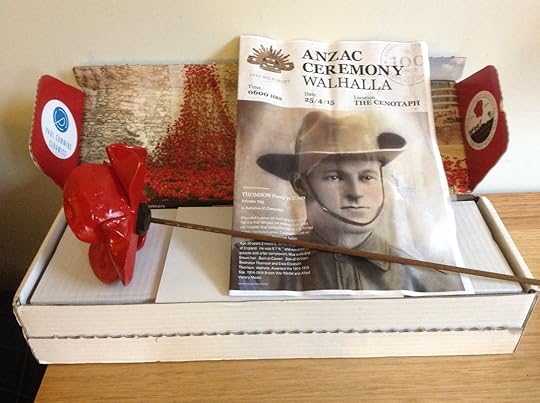 Alison's Anzac Day Blog Posts
Alison's Anzac Day Blog Posts2015: Commemorating not Celebrating Anzac Day
2014: Remembering Lemnos
2013: Anzac Day
And if you ever find yourself in Walhalla... our home away from home is Walhalla's STAR HOTEL, a reconstruction of the original Star Hotel that burned down in the 1950s
Published on April 25, 2016 00:45
April 2, 2016
**FREE** to a good home...
If you like your historical romance mixed with a decent dose of time travel... grab SECRETS IN TIME while it is free! Click here for the Buy links... http://www.alisonstuart.com/secrets-i...


Published on April 02, 2016 20:58
•
Tags:
alison-stuart, free-book, hisotorical-time-travel, secrets-in-time
February 16, 2016
New release - EXILE'S RETURN
"The breath-taking conclusion to Alison Stuart’s English Civil War trilogy introduces a heroine with nothing left to lose and a hero with everything to gain…"
Available now at all good ebook retailers... http://www.amazon.com/Exiles-Return-G...
And don't forget to enter the Guardians of the Crown CONTEST: http://www.rafflecopter.com/rafl/disp...?

Available now at all good ebook retailers... http://www.amazon.com/Exiles-Return-G...
And don't forget to enter the Guardians of the Crown CONTEST: http://www.rafflecopter.com/rafl/disp...?

Published on February 16, 2016 16:55
•
Tags:
alison-stuart, english-civil-war-fiction, exile-s-return, guardians-of-the-crown, historical-romance, rafflecopter-contest
January 26, 2016
The Convict Chains are Rattling - a post for Australia Day
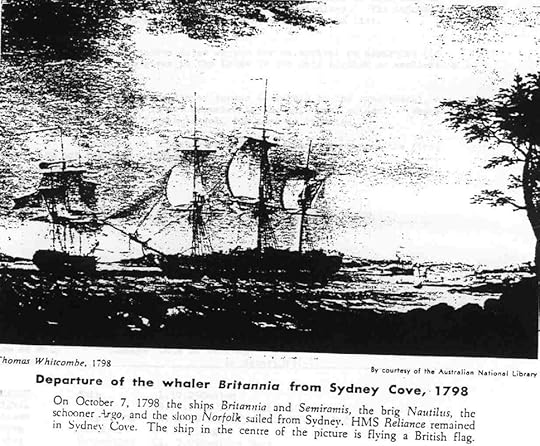
 My seditious Australian republican leanings may come as a surprise to anyone who has heard me open my mouth and commented on my lovely 'English' accent. I was not born in England and have never lived there. Australia has been my home since the age of 9. My accent is a strange amalgam of colonial crossed with Australian and many years of speech and drama lessons!
My seditious Australian republican leanings may come as a surprise to anyone who has heard me open my mouth and commented on my lovely 'English' accent. I was not born in England and have never lived there. Australia has been my home since the age of 9. My accent is a strange amalgam of colonial crossed with Australian and many years of speech and drama lessons!I was not born in Australia, neither were my parents or my grandparents or even my great grandparents. BUT my great-great grandparents and my great-great-great grandparents WERE born in Sydney, and their parents in turn came to a new country, one voluntarily and the other in chains.
So on Australia Day, I thought I would share with you the story of my convict ancestor MARY HYDE.
I have only one likeness of Mary Hyde, the dear little old lady you see in this picture (age 81 taken 3 years before her death).
These are bare facts we know about Mary - the facts that appear in the genealogy programs.
She was born in Halesowen (just outside Birmingham) on 19 February 1779. On 22nd November 1795, at the age of 16, she was arrested for theft and at the Warwick Assizes the following year she was sentenced to transportation for 7 years (more about her trial later). She did not leave England (after enduring nearly 2 years in gaol) until January 1798 aboard the Britannia III which arrived in Port Jackson on 18 July 1798.
What happened on arrival at Port Jackson is vague and I can only imagine the very worst. Mary was 18 years old and if nothing else probably had the prettiness of youth about her. Remember in 1798, the colony was only 10 years old and there were still very few women.
Robert Hughes in his book the Fatal Shore, quotes a letter from an officer aboard the Britannia, describing the arrival of the Britannia III as follows:
‘…When a ship bearing women anchored in Sydney Cove, its upper decks became a slave market, as randy colonists came swarming over the bulwarks, grinning and chumming up to the captain with a bottle of rum, while the female convicts, washed and dressed in the remnants of their English finery were mustered before them, trying as hard as they could ‘to set themselves to “advantage”. Military officers got hte first pick, then non-commissioned officers, then rivates and lastly such ex-convict settlers as seemed “respectable enough to keep a female servant…’
We have never traced a record of who took her that day. What we do know is that in September of that same year, a dashing young sea captain called John Black (whose own story is a 'boy’s own' adventure of derring do) arrived in the colony and that by May the following year, Mary had born a son. Whether the child was John’s or not, who knows, the fact remains that John Black gave the boy his name (and the second John Black went on to found the Bank of New South Wales!)
They had a second child, my great+ grandmother, Mary-Ann Black, but John and Mary never married and by 1802 John Black was dead, lost at sea bringing a cargo of gin from Calcutta (aged 25 - ‘a young man esteemed by all who knew him’). In their short life together, John had managed to obtain a pardon for Mary and had been allocated a plot of land in George Street, Sydney (the location is still marked today as the entrance to a car park bearing the street name 'DeMestre Place' (Mary Ann married Prosper deMestre bringing the land into the deMestre holdings).
Before he had left on that last voyage, John Black, entreated his friend and fellow entrepreneur, the ex-convict Simeon Lord to look after Mary. Simeon was true to his word in every sense and Mary bore him 4 children before he married her in 1814. Another 4 children followed the marriage and Mary died, much loved, at the family home in Botany (probably on the site of Sydney airport) on 12 January 1864 aged 84.
Which brings me back to Mary’s trial at the Warwick Assizes in March 1796. Amazingly we have the full transcript of her trial. The presiding judge was Spencer Percival, who went on to have the dubious distinction of being the only British Prime Minister to be assassinated and whose gravitas led to many a family joke about Mary being selected by ‘the finest judge in England’.
Mary, or as she called herself on her arrest - Sarah Blunn - was accused of stealing one black cloak, one muslin shawl, one cotton dimity petticoat, two linen shifts, two muslin gowns and two pairs of stockings, allegedly the property of Francis Deakin (her former employer) and a pair of scissors (the property of his housekeeper, Mary Mead).
Mary had gone to work as a servant for Francis Deakin and his wife. The wife had died leaving a small child, who Mary cared for. Deakin had announced that he was moving into Birmingham and had no more need of Mary. However a couple of days before the move, Mary alleged that when she was home alone with the child, a rough seaman broke into the house, knocked her down and had stolen the clothes. Following Mary’s dismissal Deakin caused a search to be made of Mary’s lodgings and there the stolen items were recovered. Mary denied taking the items, claiming all she had taken with her was her own.
Witnesses were called attesting to her good character and a subsequent petition was made to the King by many worthy gentlemen of Mary’s parish, but Percival concluded. ‘Her youth and good character would have me very desirous to find any reasonable ground for giving a lighter punishment but I thought that there was no possible doubt of her guilt that it was a very bad case of felony committed by a servant upon her master and that it was extremely aggravated by the Art she had endeavored to disguise and conceal her guilt. I see no reason to alter the opinion I then entertained.’
I have my own personal theory about Mary’s guilt and wonder if, following the death of his wife, the respectable Francis Deakin, took his young servant to his bed, paying her off with his dead wife’s clothes? But then why, as Percival noted, the elaborate ‘Art’ she used to disguise her alleged guilt? Who knows - Mary's defence was shaky and ‘prima facie’ the evidence against her was damning.
Interestingly her tombstone reads 'Mary Hyde, alias Sarah Blunn, had come out by the Transport Britannia under a 7 year sentence given at the Warwick Assizes'. She left an estate worth 11 thousand pounds.
I would have loved to have met Mary Hyde. To have survived and endured through imprisonment, transportation, possible sexual exploitation and widowhood, took an extraordinary woman, one of so many pioneering women whose stories we need to preserve.
So, you see, my ‘Australian-ness’ runs very deep, to the very founding of the colony and I hope, in my lifetime, I will see an Australian as our head of state, not a foreign monarch 12000 miles away. (As I can also trace regicides and ancestors who fought in the American War of Independence in my family tree, it seems sedition might run deep!)
PS: I am running a Rafflecopter contest to celebrate the release of EXILE'S RETURN... please click the button below to enter! ENTER CONTEST
 Spencer Percival
Spencer Percival
Published on January 26, 2016 00:49
January 23, 2016
Having a 'Gibbons' moment... When you lose your work!
The following is a reblog of an old post, prompted by the frustration of sitting down to finish a revision/edit of the current WIP only to find that the previous two days work has gone AWOL. They have vanished into the lost sock drawer of cyberspace!
While I am tempted to blame the cat (again) or my husband or any convenient third party who wanders into range, I have to admit that I have no idea where the edits have gone. Word should have autosaved them, I should have been able to recover an earlier version from Dropbox but something has gone monumentally wrong in the techonsphere of my world and I am reduced to repeating 'Decline and Fall of the Roman Empire' while downing a double gin and copious chocolate, putting on my big girl's blouse and going back to page 176 AGAIN...
Enjoy the post... (apologies for the formatting...)On Monday I suffered a "writer's disaster", 3000 of my carefully crafted word-children went wandering into the cyber woods and never came out.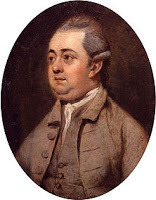 Edward GibbonsI call these moments - that awful realisation that an entire day's work has vanished - a "Gibbons" moment, for reasons I will relate. It was the fault of the cat. Come 4.30pm on the dot and Oliver Kat appears, interposing himself between the keyboard and the screen - a large furry sight screen. (I am sure he thinks his name is "Get down! You're a b@#$$%^ nuisance!"). A quick glance at my watch told me that, apart from a demanding feline, I had my own dinner to prepare before shooting off to my 6.00pm exercise class. The result was a hasty computer shut down. "Do you wish to save changes?" Word enquired. Thinking I was in the OTHER document, I clicked "No" and my day's work vanished. Now before you say...autosave...I have a new computer and it is not fully configured yet. I do all my writing in Scrivener these days. I love the "helicopter" view it gives you of the structure of your manuscript. It also autosaves so there is never a lost child. Unfortunately I considered my manuscript was "finished" (as if any manuscript ever is!). I had uploaded it as a complete manuscript (again another Scrivener feature) into Word to give me that "completed" manuscript feel on which to run my eye for minor errors and discrepancies. As so often happens, I realised it actually needed some fairly major structural work including the reordering of scenes and the writing of a couple of new chapters. Fortunately I had emailed a bit of the work with some of the more minor edits to a friend for comment but not the new writing so an afternoon's work disappeared in a key stroke. Moral of story... 1. Do major editing in Scrivener. 2. Make sure Word is configured to autosave. 3. SAVE my work at frequent intervals. In my shaky defence, if I am working in Word, I do save any work in progress to Dropbox (as well as to the hard drive of my computer) so whichever computer I am (including the iPad) I have access to my latest version. And if I feel like kicking the cat...I have to remember the loss of 3000 words is not really a disaster compared to that suffered by Edward Gibbons, the eighteenth century historian and author of a monumental treatise called THE DECLINE AND FALL OF THE ROMAN EMPIRE. Gibbons spent years writing this work, by hand, of course. The manuscript completed, it sat in his study awaiting dispatch to his publisher. The new maid, short of kindling for the fire on a cold winter's day, found a useful pile of paper and dispatched the only copy of THE DECLINE AND FALL OF THE ROMAN EMPIRE up the chimney. One can imagine she probably left his employ without a reference and Gibbons began all over again. The truth may be she didn't burn all of it...but it makes a good story!
Edward GibbonsI call these moments - that awful realisation that an entire day's work has vanished - a "Gibbons" moment, for reasons I will relate. It was the fault of the cat. Come 4.30pm on the dot and Oliver Kat appears, interposing himself between the keyboard and the screen - a large furry sight screen. (I am sure he thinks his name is "Get down! You're a b@#$$%^ nuisance!"). A quick glance at my watch told me that, apart from a demanding feline, I had my own dinner to prepare before shooting off to my 6.00pm exercise class. The result was a hasty computer shut down. "Do you wish to save changes?" Word enquired. Thinking I was in the OTHER document, I clicked "No" and my day's work vanished. Now before you say...autosave...I have a new computer and it is not fully configured yet. I do all my writing in Scrivener these days. I love the "helicopter" view it gives you of the structure of your manuscript. It also autosaves so there is never a lost child. Unfortunately I considered my manuscript was "finished" (as if any manuscript ever is!). I had uploaded it as a complete manuscript (again another Scrivener feature) into Word to give me that "completed" manuscript feel on which to run my eye for minor errors and discrepancies. As so often happens, I realised it actually needed some fairly major structural work including the reordering of scenes and the writing of a couple of new chapters. Fortunately I had emailed a bit of the work with some of the more minor edits to a friend for comment but not the new writing so an afternoon's work disappeared in a key stroke. Moral of story... 1. Do major editing in Scrivener. 2. Make sure Word is configured to autosave. 3. SAVE my work at frequent intervals. In my shaky defence, if I am working in Word, I do save any work in progress to Dropbox (as well as to the hard drive of my computer) so whichever computer I am (including the iPad) I have access to my latest version. And if I feel like kicking the cat...I have to remember the loss of 3000 words is not really a disaster compared to that suffered by Edward Gibbons, the eighteenth century historian and author of a monumental treatise called THE DECLINE AND FALL OF THE ROMAN EMPIRE. Gibbons spent years writing this work, by hand, of course. The manuscript completed, it sat in his study awaiting dispatch to his publisher. The new maid, short of kindling for the fire on a cold winter's day, found a useful pile of paper and dispatched the only copy of THE DECLINE AND FALL OF THE ROMAN EMPIRE up the chimney. One can imagine she probably left his employ without a reference and Gibbons began all over again. The truth may be she didn't burn all of it...but it makes a good story!
 The 6 volumes of Decline and Fall of the Roman EmpireAnd Edward is in good (if somewhat strange company). Jilly Coooper relates the tale of her lost manuscript "It was awful, awful. I'd finished the first draft, I went out to lunch and then I got the bus home – the number 22 bus – and I left it behind. I had this somewhat lovely fantasy of the West Indian bus driver publishing a novel about showjumping but it never happened. Everyone was very kind and the Evening Standard put out an appeal. That was 1970 I think. Then I suppose it was 14 years later, I started writing it again. I hate to be conceited but I think it's probably one of the best books I ever wrote because the characters had built up over 15 years." So whenever I lose any writing, I just keeping repeating "Decline and Fall of the Roman Empire" as a mantra and I feel much better. HAVE YOU HAD ANY "GIBBONS" MOMENTS OR TIPS FOR NOT LOSING YOUR WORK?
The 6 volumes of Decline and Fall of the Roman EmpireAnd Edward is in good (if somewhat strange company). Jilly Coooper relates the tale of her lost manuscript "It was awful, awful. I'd finished the first draft, I went out to lunch and then I got the bus home – the number 22 bus – and I left it behind. I had this somewhat lovely fantasy of the West Indian bus driver publishing a novel about showjumping but it never happened. Everyone was very kind and the Evening Standard put out an appeal. That was 1970 I think. Then I suppose it was 14 years later, I started writing it again. I hate to be conceited but I think it's probably one of the best books I ever wrote because the characters had built up over 15 years." So whenever I lose any writing, I just keeping repeating "Decline and Fall of the Roman Empire" as a mantra and I feel much better. HAVE YOU HAD ANY "GIBBONS" MOMENTS OR TIPS FOR NOT LOSING YOUR WORK?
While I am tempted to blame the cat (again) or my husband or any convenient third party who wanders into range, I have to admit that I have no idea where the edits have gone. Word should have autosaved them, I should have been able to recover an earlier version from Dropbox but something has gone monumentally wrong in the techonsphere of my world and I am reduced to repeating 'Decline and Fall of the Roman Empire' while downing a double gin and copious chocolate, putting on my big girl's blouse and going back to page 176 AGAIN...
Enjoy the post... (apologies for the formatting...)On Monday I suffered a "writer's disaster", 3000 of my carefully crafted word-children went wandering into the cyber woods and never came out.
 Edward GibbonsI call these moments - that awful realisation that an entire day's work has vanished - a "Gibbons" moment, for reasons I will relate. It was the fault of the cat. Come 4.30pm on the dot and Oliver Kat appears, interposing himself between the keyboard and the screen - a large furry sight screen. (I am sure he thinks his name is "Get down! You're a b@#$$%^ nuisance!"). A quick glance at my watch told me that, apart from a demanding feline, I had my own dinner to prepare before shooting off to my 6.00pm exercise class. The result was a hasty computer shut down. "Do you wish to save changes?" Word enquired. Thinking I was in the OTHER document, I clicked "No" and my day's work vanished. Now before you say...autosave...I have a new computer and it is not fully configured yet. I do all my writing in Scrivener these days. I love the "helicopter" view it gives you of the structure of your manuscript. It also autosaves so there is never a lost child. Unfortunately I considered my manuscript was "finished" (as if any manuscript ever is!). I had uploaded it as a complete manuscript (again another Scrivener feature) into Word to give me that "completed" manuscript feel on which to run my eye for minor errors and discrepancies. As so often happens, I realised it actually needed some fairly major structural work including the reordering of scenes and the writing of a couple of new chapters. Fortunately I had emailed a bit of the work with some of the more minor edits to a friend for comment but not the new writing so an afternoon's work disappeared in a key stroke. Moral of story... 1. Do major editing in Scrivener. 2. Make sure Word is configured to autosave. 3. SAVE my work at frequent intervals. In my shaky defence, if I am working in Word, I do save any work in progress to Dropbox (as well as to the hard drive of my computer) so whichever computer I am (including the iPad) I have access to my latest version. And if I feel like kicking the cat...I have to remember the loss of 3000 words is not really a disaster compared to that suffered by Edward Gibbons, the eighteenth century historian and author of a monumental treatise called THE DECLINE AND FALL OF THE ROMAN EMPIRE. Gibbons spent years writing this work, by hand, of course. The manuscript completed, it sat in his study awaiting dispatch to his publisher. The new maid, short of kindling for the fire on a cold winter's day, found a useful pile of paper and dispatched the only copy of THE DECLINE AND FALL OF THE ROMAN EMPIRE up the chimney. One can imagine she probably left his employ without a reference and Gibbons began all over again. The truth may be she didn't burn all of it...but it makes a good story!
Edward GibbonsI call these moments - that awful realisation that an entire day's work has vanished - a "Gibbons" moment, for reasons I will relate. It was the fault of the cat. Come 4.30pm on the dot and Oliver Kat appears, interposing himself between the keyboard and the screen - a large furry sight screen. (I am sure he thinks his name is "Get down! You're a b@#$$%^ nuisance!"). A quick glance at my watch told me that, apart from a demanding feline, I had my own dinner to prepare before shooting off to my 6.00pm exercise class. The result was a hasty computer shut down. "Do you wish to save changes?" Word enquired. Thinking I was in the OTHER document, I clicked "No" and my day's work vanished. Now before you say...autosave...I have a new computer and it is not fully configured yet. I do all my writing in Scrivener these days. I love the "helicopter" view it gives you of the structure of your manuscript. It also autosaves so there is never a lost child. Unfortunately I considered my manuscript was "finished" (as if any manuscript ever is!). I had uploaded it as a complete manuscript (again another Scrivener feature) into Word to give me that "completed" manuscript feel on which to run my eye for minor errors and discrepancies. As so often happens, I realised it actually needed some fairly major structural work including the reordering of scenes and the writing of a couple of new chapters. Fortunately I had emailed a bit of the work with some of the more minor edits to a friend for comment but not the new writing so an afternoon's work disappeared in a key stroke. Moral of story... 1. Do major editing in Scrivener. 2. Make sure Word is configured to autosave. 3. SAVE my work at frequent intervals. In my shaky defence, if I am working in Word, I do save any work in progress to Dropbox (as well as to the hard drive of my computer) so whichever computer I am (including the iPad) I have access to my latest version. And if I feel like kicking the cat...I have to remember the loss of 3000 words is not really a disaster compared to that suffered by Edward Gibbons, the eighteenth century historian and author of a monumental treatise called THE DECLINE AND FALL OF THE ROMAN EMPIRE. Gibbons spent years writing this work, by hand, of course. The manuscript completed, it sat in his study awaiting dispatch to his publisher. The new maid, short of kindling for the fire on a cold winter's day, found a useful pile of paper and dispatched the only copy of THE DECLINE AND FALL OF THE ROMAN EMPIRE up the chimney. One can imagine she probably left his employ without a reference and Gibbons began all over again. The truth may be she didn't burn all of it...but it makes a good story!
 The 6 volumes of Decline and Fall of the Roman EmpireAnd Edward is in good (if somewhat strange company). Jilly Coooper relates the tale of her lost manuscript "It was awful, awful. I'd finished the first draft, I went out to lunch and then I got the bus home – the number 22 bus – and I left it behind. I had this somewhat lovely fantasy of the West Indian bus driver publishing a novel about showjumping but it never happened. Everyone was very kind and the Evening Standard put out an appeal. That was 1970 I think. Then I suppose it was 14 years later, I started writing it again. I hate to be conceited but I think it's probably one of the best books I ever wrote because the characters had built up over 15 years." So whenever I lose any writing, I just keeping repeating "Decline and Fall of the Roman Empire" as a mantra and I feel much better. HAVE YOU HAD ANY "GIBBONS" MOMENTS OR TIPS FOR NOT LOSING YOUR WORK?
The 6 volumes of Decline and Fall of the Roman EmpireAnd Edward is in good (if somewhat strange company). Jilly Coooper relates the tale of her lost manuscript "It was awful, awful. I'd finished the first draft, I went out to lunch and then I got the bus home – the number 22 bus – and I left it behind. I had this somewhat lovely fantasy of the West Indian bus driver publishing a novel about showjumping but it never happened. Everyone was very kind and the Evening Standard put out an appeal. That was 1970 I think. Then I suppose it was 14 years later, I started writing it again. I hate to be conceited but I think it's probably one of the best books I ever wrote because the characters had built up over 15 years." So whenever I lose any writing, I just keeping repeating "Decline and Fall of the Roman Empire" as a mantra and I feel much better. HAVE YOU HAD ANY "GIBBONS" MOMENTS OR TIPS FOR NOT LOSING YOUR WORK?
Published on January 23, 2016 00:51
January 22, 2016
Contest!
To celebrate the release of the 3rd (and final) book in the Guardians of the Crown series, EXILE'S RETURN, Alison is running a contest for some GUARDIANS OF THE CROWN swag... (including a canvas tote, mouse mat, pen, figurine and keyring).
ENTER THE RAFFLECOPTER using this link:http://www.rafflecopter.com/rafl/disp...?
or go to http://www.alisonstuart.com/contests-...

Exile's Return
ENTER THE RAFFLECOPTER using this link:http://www.rafflecopter.com/rafl/disp...?
or go to http://www.alisonstuart.com/contests-...

Exile's Return
Published on January 22, 2016 21:28
•
Tags:
alison-stuart, english-civil-war-fiction, exile-s-return, guardians-of-the-crown, historical-romance, rafflecopter-contest



